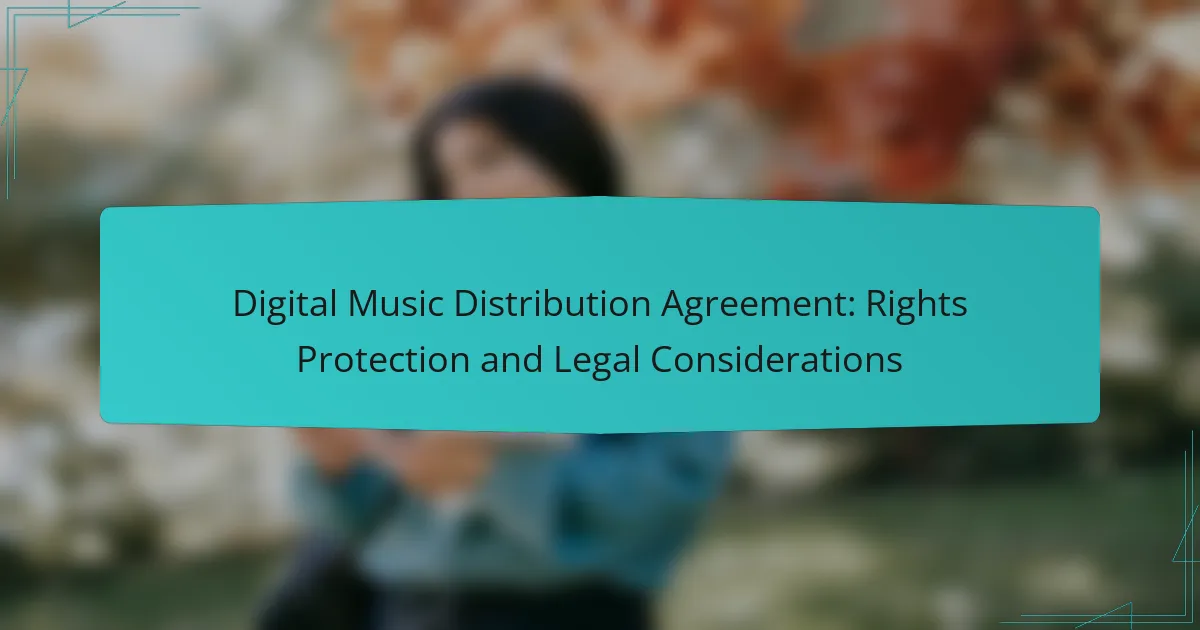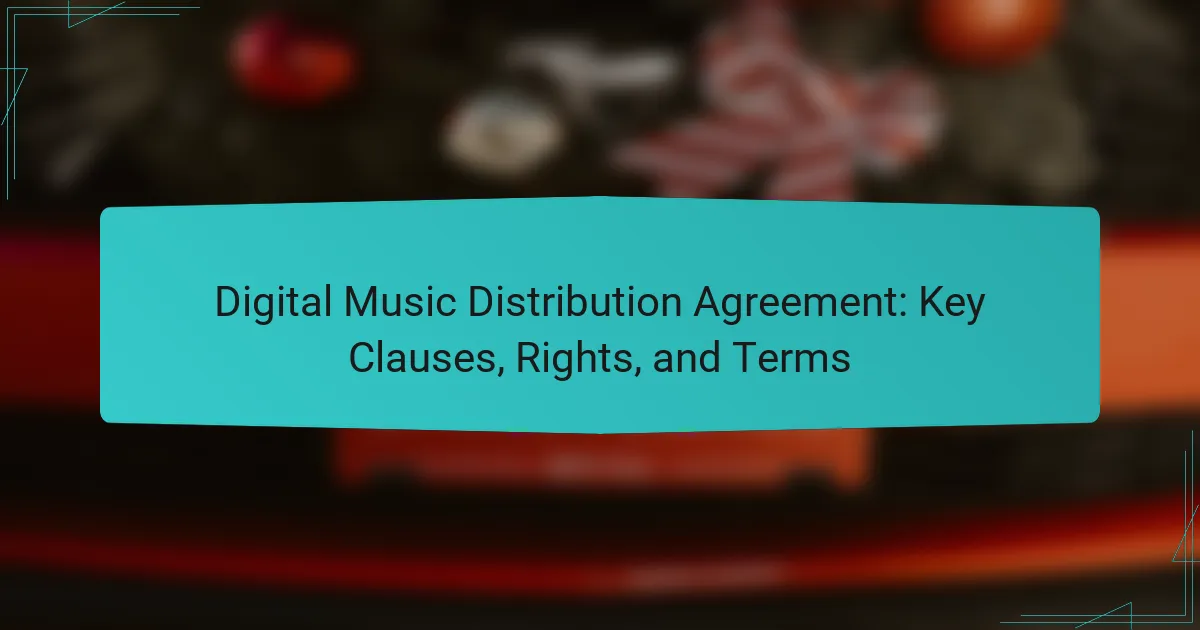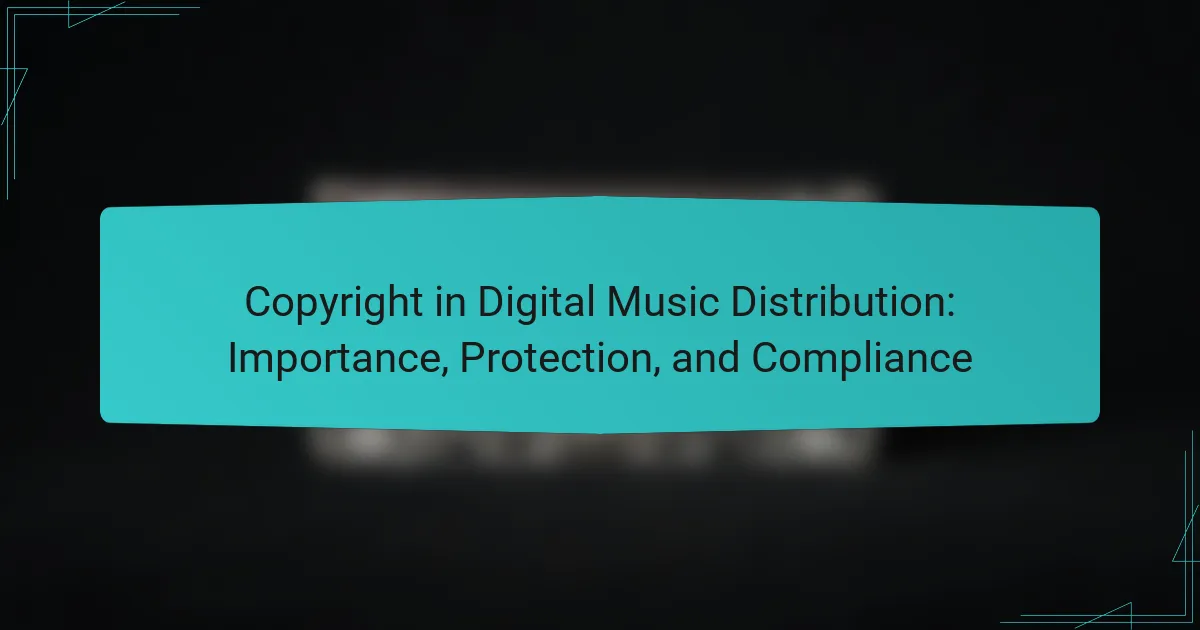A digital music distribution agreement serves as a crucial framework that defines the relationship between artists and distributors, detailing essential terms such as rights granted, revenue sharing, and dispute resolution. By clearly outlining ownership and usage terms, these agreements protect the rights of music creators while enabling distributors to effectively manage the distribution process. Artists must navigate various legal considerations, including copyright laws and digital rights management, to safeguard their interests and ensure fair compensation.
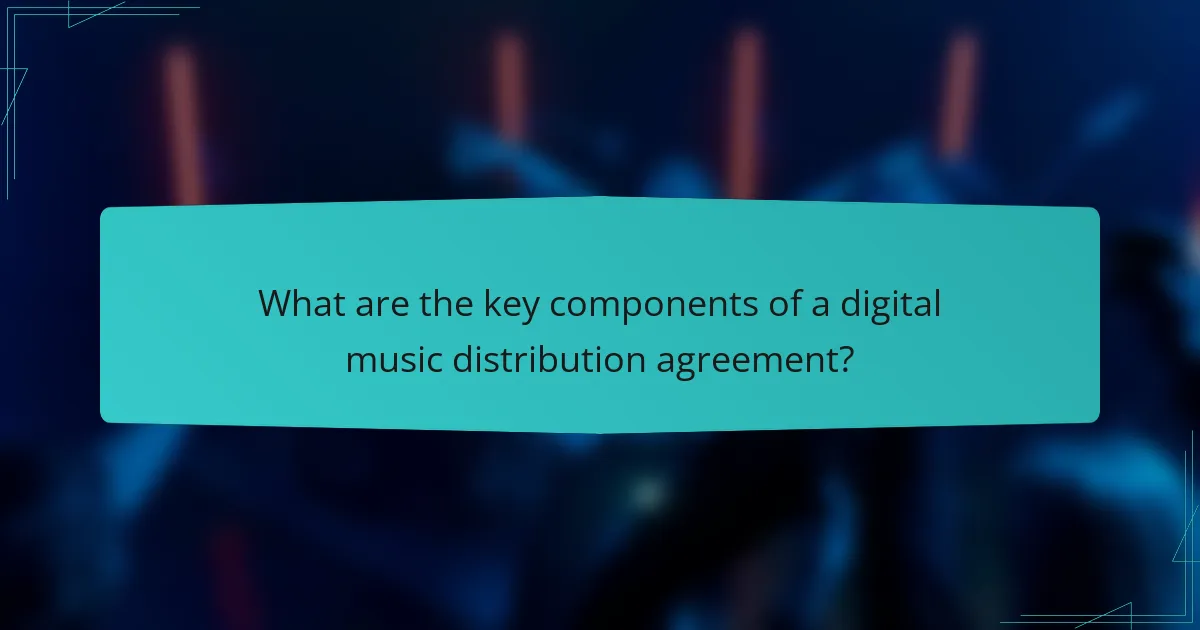
What are the key components of a digital music distribution agreement?
A digital music distribution agreement outlines the essential terms between artists and distributors regarding the distribution of music. Key components include rights granted, revenue sharing, duration, termination clauses, and dispute resolution procedures.
Rights granted to distributors
The rights granted to distributors typically include the authority to distribute the artist’s music across various platforms, such as streaming services and digital stores. This can also encompass the right to use the music for promotional purposes.
Artists should ensure that the agreement specifies the scope of these rights, including geographical limitations and the duration of the distribution rights. It’s crucial to retain certain rights, such as those related to licensing for sync or other media uses.
Revenue sharing models
Revenue sharing models dictate how earnings from music sales and streams are divided between the artist and the distributor. Common models include a percentage split, where artists might receive anywhere from 70% to 90% of the revenue, depending on the agreement.
Artists should evaluate different models carefully, as some distributors may offer lower upfront costs but take a larger cut of future earnings. Understanding the financial implications of each model is essential for maximizing income.
Duration of the agreement
The duration of a digital music distribution agreement specifies how long the distributor has the rights to distribute the artist’s music. This period can range from one year to several years, depending on the terms negotiated.
Artists should consider whether they want a short-term agreement that allows for flexibility or a longer-term commitment that may provide stability. It’s important to include renewal options or review periods to reassess the partnership.
Termination clauses
Termination clauses outline the conditions under which either party can end the agreement. Common reasons for termination include breach of contract, failure to meet sales targets, or mutual consent.
Artists should ensure that the termination process is clearly defined, including notice periods and any obligations that remain after termination, such as payment of outstanding royalties. This clarity helps prevent disputes later on.
Dispute resolution procedures
Dispute resolution procedures detail how conflicts between the artist and distributor will be handled. This may include mediation, arbitration, or litigation, and should specify the governing law and jurisdiction.
Including clear procedures can save time and resources in the event of a disagreement. Artists should consider opting for mediation as a first step, as it is often less costly and more amicable than litigation.
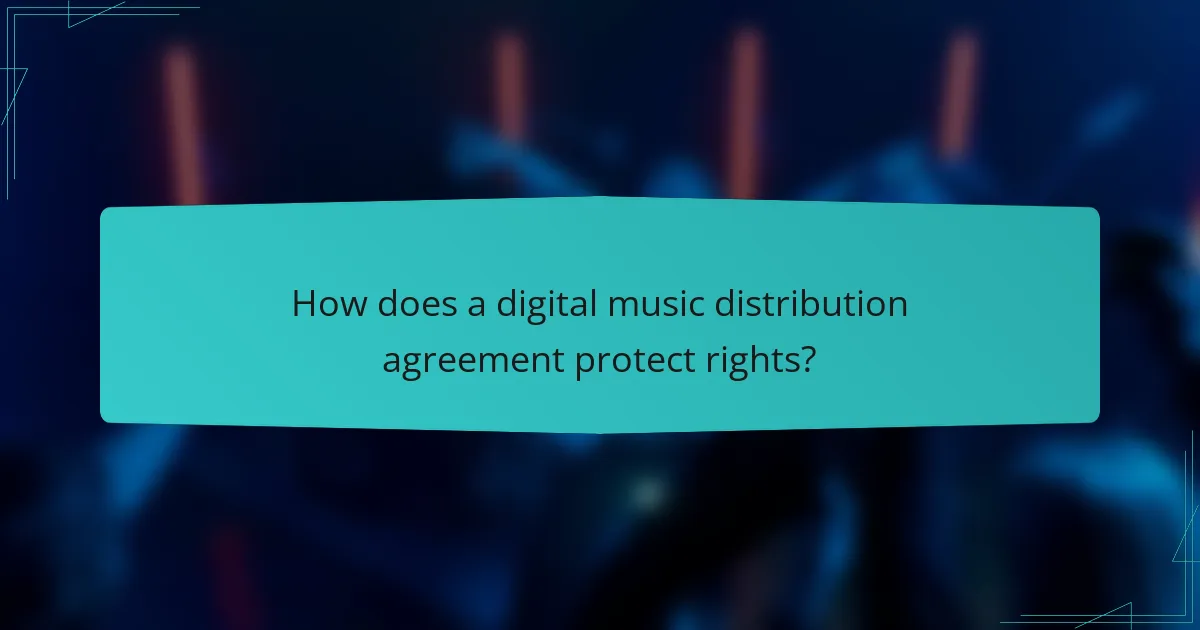
How does a digital music distribution agreement protect rights?
A digital music distribution agreement protects rights by clearly defining ownership and usage terms for music creators and distributors. This legal framework ensures that artists retain control over their work while allowing distributors to manage the distribution process effectively.
Copyright protection mechanisms
Copyright protection mechanisms in a digital music distribution agreement include the registration of works with relevant authorities and the assignment of rights to distributors. Artists typically retain copyright ownership, granting licenses to distributors for specific uses, such as streaming or downloading.
Additionally, agreements often include clauses that outline how royalties are calculated and distributed, ensuring that artists receive fair compensation for their work. This transparency is crucial for maintaining trust between artists and distributors.
Licensing terms for streaming platforms
Licensing terms for streaming platforms specify how music can be used and monetized on various services. These terms often vary by platform, with some requiring exclusive rights while others allow for non-exclusive agreements. Understanding these differences is vital for artists to maximize their reach and revenue.
Typically, agreements will detail the duration of the license, territorial rights, and any limitations on usage. Artists should carefully review these terms to ensure they align with their distribution goals and do not inadvertently restrict their ability to license music elsewhere.
Protection against unauthorized use
Protection against unauthorized use is a critical aspect of digital music distribution agreements. These agreements often include provisions for monitoring and enforcing rights, such as the ability to take legal action against infringers. This helps safeguard an artist’s work from piracy and unauthorized distribution.
Moreover, many agreements incorporate technology solutions, such as digital rights management (DRM), to prevent unauthorized copying and sharing. Artists should ensure that their agreements include robust enforcement mechanisms to protect their intellectual property effectively.
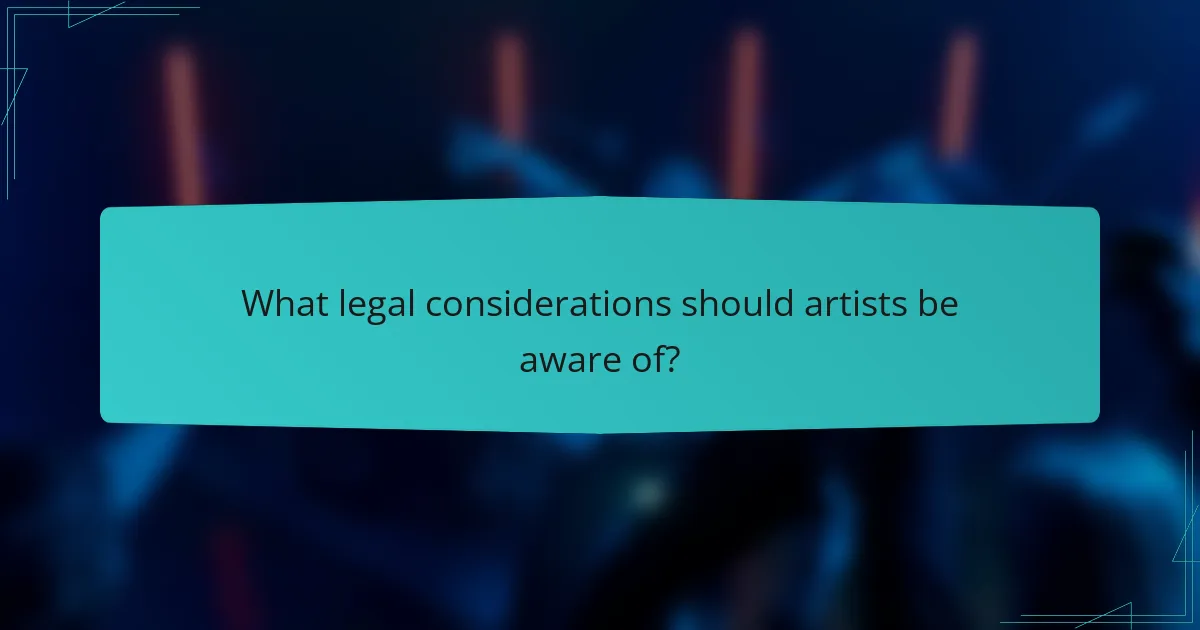
What legal considerations should artists be aware of?
Artists must be aware of various legal considerations when entering a digital music distribution agreement, including copyright laws, digital rights management, and the negotiation of terms. Understanding these aspects is crucial for protecting their rights and ensuring fair compensation.
Understanding copyright laws
Copyright laws grant artists exclusive rights to their original works, including music, lyrics, and recordings. In the digital realm, these laws protect against unauthorized use and distribution of their content. Artists should familiarize themselves with copyright registration processes to strengthen their legal standing.
In many countries, copyright protection is automatic upon creation, but registering with a relevant authority can provide additional benefits, such as the ability to enforce rights in court. Artists should also be aware of the duration of copyright, which typically lasts for the life of the creator plus several decades, depending on local laws.
Implications of digital rights management
Digital rights management (DRM) refers to technologies that control how digital music is used and distributed. While DRM can help prevent unauthorized sharing, it may also limit how artists can distribute their work. Understanding the implications of DRM is essential for artists to balance protection with accessibility.
Artists should consider whether they want to allow their music to be streamed, downloaded, or shared freely. Some platforms may impose strict DRM that could hinder promotional efforts or fan engagement. Evaluating the terms of distribution agreements regarding DRM can help artists make informed decisions.
Negotiating favorable terms
Negotiating favorable terms in a digital music distribution agreement is vital for artists to ensure they retain control over their work and receive fair compensation. Key aspects to negotiate include royalty rates, distribution rights, and the duration of the contract.
Artists should aim for a royalty rate that reflects industry standards, which can vary widely but often falls between 15-30% of sales. It’s also important to clarify the rights granted to the distributor, ensuring that artists maintain ownership and can exploit their music across different platforms. Seeking legal advice during negotiations can help artists secure better terms and avoid common pitfalls.
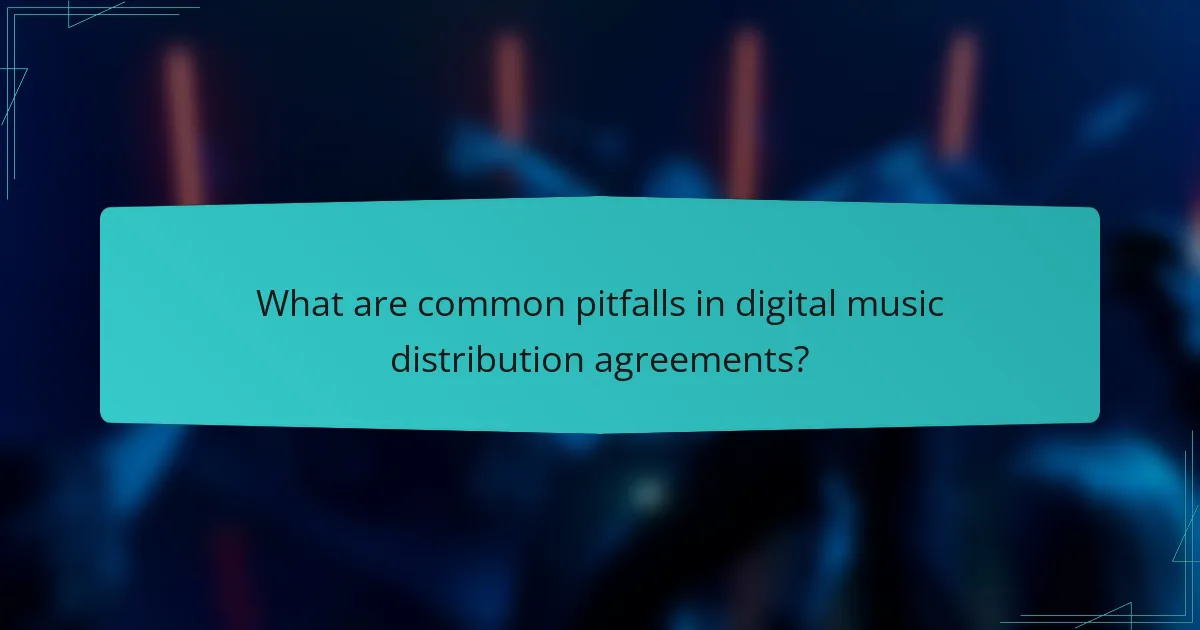
What are common pitfalls in digital music distribution agreements?
Common pitfalls in digital music distribution agreements include ambiguous language, unclear revenue splits, and overly restrictive terms. These issues can lead to misunderstandings and financial losses for artists and producers.
Ambiguous language in contracts
Ambiguous language can create confusion about the rights and obligations of each party in a digital music distribution agreement. Terms that are not clearly defined may lead to disputes over interpretation, potentially resulting in costly legal battles.
To avoid ambiguity, ensure that all terms are explicitly defined. For example, instead of using vague phrases like “reasonable efforts,” specify what actions are required and the timeframe for completion.
Lack of clarity on revenue splits
A lack of clarity on revenue splits can significantly impact an artist’s earnings. If the agreement does not clearly outline how revenue from digital sales and streaming will be divided, artists may receive less than expected.
It’s essential to detail the percentages for each party involved, including any deductions for fees or expenses. For instance, if a distributor takes a 15% cut, this should be explicitly stated along with how the remaining revenue is allocated.
Overly restrictive terms
Overly restrictive terms can limit an artist’s ability to promote their music or collaborate with others. Clauses that prevent artists from working with competing platforms or engaging in certain promotional activities can hinder their growth and exposure.
Review the agreement for terms that may be unnecessarily limiting. For example, avoid exclusivity clauses that last longer than a few months unless they offer substantial benefits. Always negotiate for flexibility to adapt to changing market conditions.
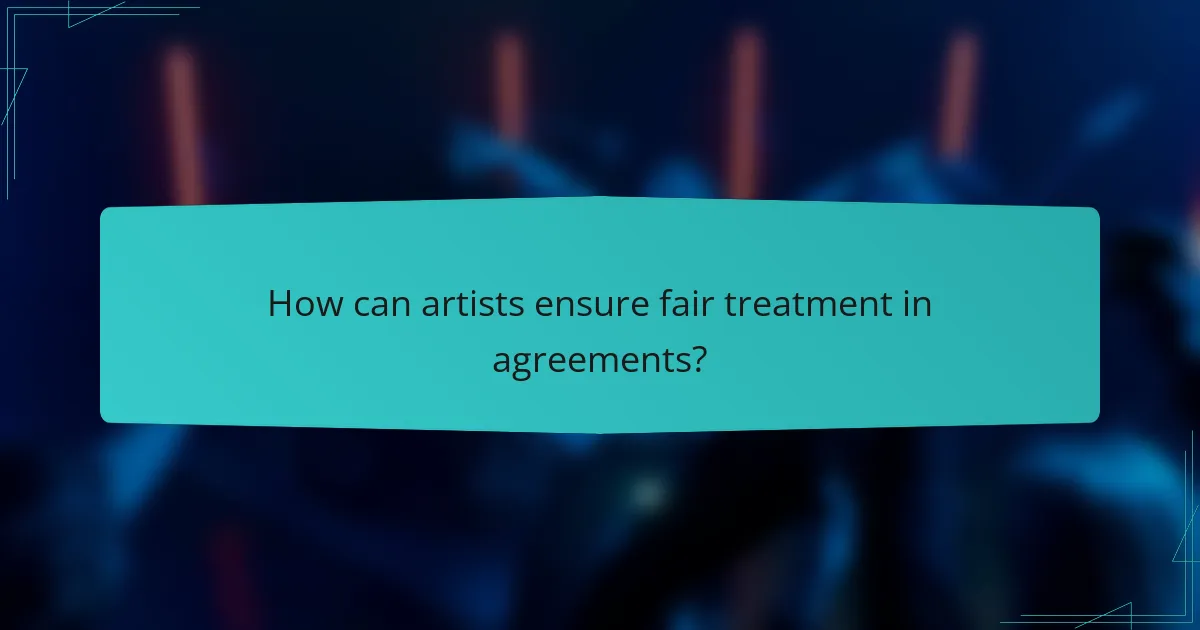
How can artists ensure fair treatment in agreements?
Artists can ensure fair treatment in digital music distribution agreements by understanding their rights and seeking professional guidance. Clear communication and negotiation of terms are essential to protect their interests and maximize their earnings.
Consulting with legal professionals
Consulting with legal professionals is crucial for artists entering digital music distribution agreements. A qualified attorney can help interpret complex legal jargon, ensuring that artists fully understand the implications of each clause in the contract.
Legal experts can also identify potential pitfalls, such as unfair revenue splits or restrictive terms that could limit an artist’s creative freedom. By reviewing agreements, they can negotiate more favorable conditions, such as retaining ownership of master recordings or securing a higher percentage of royalties.
When selecting a legal professional, artists should look for someone with experience in the music industry. This ensures that the lawyer is familiar with common practices and can provide tailored advice that aligns with the artist’s goals and needs.
